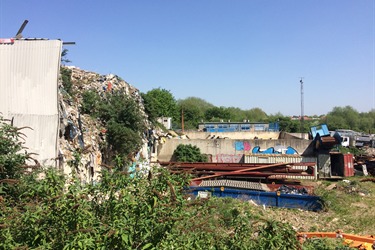_221.jpg) There’s a garage site a stone’s throw away from Tottenham Hale Station that is designated as Green Belt, but there is not a blade of grass to be seen. In fact, apart from a green car parked in the garage, there is no green to be seen anywhere.
There’s a garage site a stone’s throw away from Tottenham Hale Station that is designated as Green Belt, but there is not a blade of grass to be seen. In fact, apart from a green car parked in the garage, there is no green to be seen anywhere.
Why does this matter? Because this Green Belt designation has prevented a Housing Association from building affordable homes on the site.
The Ministry of Housing, Communities and Local Government's consultation regarding the National Planning Policy Framework provided the perfect opportunity to make this case. Along with Politicians, academics, economists, charities and Housing Associations, Siobhain submitted the below proposal.
You can read more about the campaign here: City AM, Telegraph, Evening Standard, The Times, City Metric.
Group Submission
Background: A Crisis of Housing Supply
There is a broad consensus that Britain, in general, England in particular, and London most of all, is suffering from a near housing crisis: of affordability and supply. The epicentre of this crisis is London and its wider region although there are grave problems of access and affordability elsewhere. The Government has adopted an ambitious target of generating an additional 300,000 homes a year for England. The 2018 GLA draft plan has an annual target of 65,000 ‘net additions’ a year. This would be well over double the average achieved in the past 10 years.
These ambitious targets need to be set in the context of history. Historically housing targets were set in terms of building. There was recognition as long as 20 years ago that there was an impending problem of housing supply and affordability. The Barker Review was set up in 2002 to address these problems. Out of that a target for annual house building of 240,000 emerged in 2007 with 2m of the target to be built by 2016. In the outturn only 1.3m houses were built in that 10 years and in 2016 annual building, far from being 240,000 a year, was 140,000. In 2007 the GLA established an annual target of 31,505 houses (raised to 33,400 in 2009). The actual number of houses built in the GLA from 2007 to 2016 averaged 20,709 – only about one third of the current target.

The point of this is to emphasise the long term nature of our housing supply problem and the difficulty of tackling it without radical changes. The revision of the National Planning Policy Framework provides an opportunity make a constructive start to improving our ability to build more houses.
The Green Belt
A critical factor contributing to the difficulty in building houses accessible to jobs is the supply of land. One policy, the Metropolitan Green Belt, prevents building over an area more than three times that of the GLA: the Metropolitan Green Belt accounts for nearly one third of all Green Belt land in England despite the pressure of demand for housing being highest in this region. In all, Green Belt designation prevents any building over an area nearly half as big again as all urbanised land in England. Green Belts were established not to preserve open countryside for environmental or recreational use but to stop settlements merging and safeguard historic towns. We strongly support the NPPF’s overriding goals of protecting the environment and our beautiful country side and promoting sustainable transport and development which complements that. But the NPPF also, rightly, supports a presumption in favour of sustainable development.
Proposal
With these considerations in mind we would suggest that there should be a presumption in favour of permitting development of any land within one kilometre of a train station (TfL or National Rail) which provides access to London Zone 1 within a 45 minute travel time unless that land fell into one or more of these categories:
Protected under the Birds and Habitats Directives and/or designated as Sites of Special Scientific Interest; land designated as Local Green Space, an Area of Outstanding Natural Beauty; land within a National Park (or the Broads Authority) or defined as Heritage Coast; irreplaceable habitats including ancient woodland; aged or veteran trees; designated heritage assets (and other heritage assets of archaeological interest referred to in footnote 55 of the draft NPPF); and areas at risk of flooding or coastal change.
It is judged that this proposal would reflect the overarching goal of promoting sustainable development and greatly improve the supply of housing since land capable of providing more than 1 million homes could be released. It would give reality to the aim of promoting sustainable transport. The purposes of Green Belt designation set out in the NPPF para 133 do not include any environmental or recreational benefits; the exemptions set out above would ensure that no land of significant environmental or amenity value could be developed and, in reality, much of the land which would be made available for development is not green at all. There should, therefore, be no concern that the aim of sustainable development would be impaired, especially since there would be significant benefits in terms of improving sustainable transport.

This proposal, if implemented, would not lessen the protection of any Green Belt land further than one kilometre from a station giving access to London Zone 1 within 45 minutes. But it would yield a presumption of residential-led development for land close to such stations. In the first instance local communities would be encouraged to develop plans detailing the form of development acceptable on the released land and setting out other guidelines for its development. However, the housing crisis is urgent and to avoid protracted delay this process should be confined to a reasonable time limit. How long it would be reasonable to allow for the formulation of local plans for the use of the released land should be agreed after the adoption of this revised NPPF provision.
Conclusion
The signatories of this submission call upon the Ministry of Housing, Communities and Local Government to enable, under the revised National Planning Policy Framework, a presumption in favour of housebuilding on Green Belt land within 1 Km (roughly a 10-minute walk) of a tube or train station giving access to London Zone 1 within 45 minute travel time except for land falling into the exemptions outlined in this proposal.
Submission Signatories
Parliamentarians
Siobhain McDonagh, Labour MP for Mitcham and Morden
Nick Boles, Conservative MP for Grantham and Stamford
Rt Hon David Lammy, Labour MP for Tottenham
Chuka Umunna, Labour MP for Streatham
Sir Peter Bottomley, Conservative MP for Worthing West
Karen Buck, Labour MP for Westminster North
Neil Coyle, Labour MP for Bermondsey and Old Southwark
Rt Hon Robert Halfon, Conservative MP for Harlow
Seema Malhotra, Labour MP for Feltham and Heston
Rt Hon Dame Margaret Hodge, Labour MP for Barking
Dr Rupa Huq, Labour MP for Ealing Central and Acton
Marie Rimmer, Labour MP for St Helens South and Whiston
Lloyd Russell-Moyle, Labour MP for Brighton, Kemptown
Matt Western, Labour MP for Warwick and Leamington
The Rt Hon. The Lord Adonis
Lord Wolfson of Aspley Guise, Conservative
Lord Richard Layard, Labour
Lord Lucas, Conservative
Viscount Ridley DL, Conservative
All Party Parliamentary Group for London Planning and Built Environment
Organisations
Mark Littlewood, Director General of the Institute of Economic Affairs
Sam Dumitriu, Head of Research, Adam Smith Institute
Philip Salter, Founder, The Entrepreneurs Network
Graeme Leach, Chief Executive and Chief Economist of Macronomics
Andrew Carter, Chief Executive, Centre for Cities
Peter Murray, Chairman of the London Society
London YIMBY
Geoff Beacon, Chair of the Pollution Tax Association
Taxpayers’ Alliance
Reuben Young, Director, PricedOut
Oxford YIMBY
Jon Manns, House Me London Campaign Group
Sean McKee, Director of Policy and Public Affairs, London Chamber of Commerce and Industry (LCCI has a particular focus on poor quality green belt land being unlocked to house London’s emergency services workers).
Nicholas Falk Executive Director of The URBED Trust
Chris Rumfitt, Chief Executive, Field Consulting
Ufuk Bahar, Managing Director at Urbanist Architecture
Duncan Bowie, Senior Research Associate, Bartlett School of Planning; Chair, Highbury Group on Housing Delivery; Convenor, London and Wider South East Strategic Planning Network
Mark Kingsley-Williams, Founder, LawPanel
Simon Hawtin, Director Hawtin Estates Limited
Jack Powell, Editor-in-Chief of 1828
Housing Associations and Trusts
g15 London:
A2Dominion
Catalyst Housing Association
Clarion Housing Group
Hyde Housing
London and Quadrant Housing Trust
Metropolitan
Network Homes
Notting Hill Genesis
Optivo
Peabody
Southern Housing Group
Newlon Housing Trust
Origin Housing Association
MOAT Housing Association
Women’s Pioneer Housing Association
The Whiteley Homes Trust
The Abbeyfield Society
Academics
Professor Paul Cheshire, London School of Economics
Professor Christian Hilber, London School of Economics
Professor Ian Gordon, London School of Economics
Professor Michael Ball, University of Reading